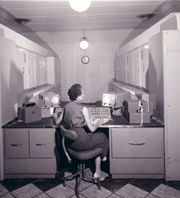Stored programs
Early computing machines had fixed programs. Changing its function required the re-wiring and re-structuring of the machine.
[28] With the proposal of the stored-program computer this changed. A stored-program computer includes by design an
instruction set and can store in memory a set of instructions (a
program) that details the
computation. The theoretical basis for the stored-program computer was laid by
Alan Turing in his 1936 paper. In 1945 Turing joined the
National Physical Laboratory
and began work on developing an electronic stored-program digital
computer. His 1945 report "Proposed Electronic Calculator" was the first
specification for such a device. John von Neumann at the
University of Pennsylvania also circulated his
First Draft of a Report on the EDVAC in 1945.
[18]
The Manchester Small-Scale Experimental Machine, nicknamed
Baby, was the world's first
stored-program computer. It was built at the
Victoria University of Manchester by
Frederic C. Williams,
Tom Kilburn and
Geoff Tootill, and ran its first program on 21 June 1948.
[37] It was designed as a
testbed for the
Williams tube, the first
random-access digital storage device.
[38]
Although the computer was considered "small and primitive" by the
standards of its time, it was the first working machine to contain all
of the elements essential to a modern electronic computer.
[39]
As soon as the SSEM had demonstrated the feasibility of its design, a
project was initiated at the university to develop it into a more usable
computer, the
Manchester Mark 1.
The Mark 1 in turn quickly became the prototype for the
Ferranti Mark 1, the world's first commercially available general-purpose computer.
[40] Built by
Ferranti, it was delivered to the
University of Manchester in February 1951. At least seven of these later machines were delivered between 1953 and 1957, one of them to
Shell labs in
Amsterdam.
[41] In October 1947, the directors of British catering company
J. Lyons & Company decided to take an active role in promoting the commercial development of computers. The
LEO I computer became operational in April 1951
[42] and ran the world's first regular routine office computer
job.


No comments:
Post a Comment